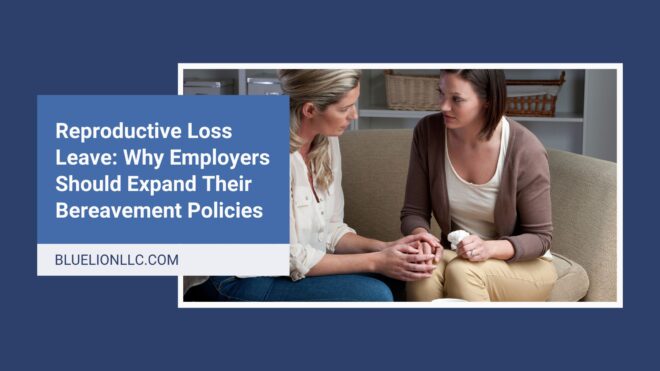
While bereavement leave is not federally required in the United States, many employers voluntarily offer this benefit through a bereavement policy or paid time off (PTO) policy.
Despite this, fertility-related loss—including miscarriage, stillbirth, and failed fertility treatments—is often excluded from traditional bereavement policies. But it’s time to acknowledge the emotional, physical, and psychological toll of reproductive loss and support employees during these times.
After all, it’s more common than many realize. The March of Dimes reports that between 10 to 20% of known pregnancies end in miscarriage, while the CDC notes that about 21,000 babies are stillborn yearly. Then, there are those suffering from failed adoptions, surrogacies, and fertility treatments, all of which are a bit more complex when it comes to the numbers—yet these families face trauma as well.
Reproductive loss leave is finally on the rise as employers prioritize employee well-being and strive to boost retention. Whether you incorporate it into your current bereavement leave policy or create a separate policy, it’s a powerful way to show employees you genuinely care about their mental and physical health.
A Glance at the Current State of Fertility-Related Loss Leave
Traditional bereavement leave often focuses on the death of immediate family members, failing to address reproductive loss. This leaves employees in this situation:
- Confused about what kind of leave they should take
- Concerned about the impact on their workload and/or job status
- Stressed about reduced pay—or unpaid leave altogether
Bottom line: Lacking a reproductive leave policy can cause even more stress during a time of grief. In turn, it can lead to decreased morale, productivity, and retention.
Unsurprisingly, many employers now offer this employee benefit, which is in increasing demand—especially among the younger workforce. Research by MetLife found that employees’ satisfaction with their benefits dropped to 61% in 2023 from 64% in 2022, hitting its lowest point in the past decade.
Offering fertility-related loss leave is both the right thing to do and helps employers stand out in a competitive job market where top talent no longer tolerates subpar benefits that don’t support their needs.
Big names like Goldman Sachs and Pinterest are leading the way. Goldman Sachs added 20 days of paid leave for an employee, spouse, or surrogate who has a miscarriage or stillbirth. Pinterest provides four weeks of paid leave to parents who undergo a miscarriage.
Legal Protections & Limitations
As with so many areas, U.S. leave protections vary widely between state and local jurisdictions. A few states, like Illinois and California, offer only unpaid leave for reproductive loss, which many employees can’t afford.
The same issue applies to the Family and Medical Leave Act (FMLA). Although it doesn’t apply to bereavement, FMLA provides eligible employees with up to 12 weeks of unpaid leave for serious health conditions, which may include complications from reproductive loss. However, FMLA only applies to employers with 50 or more employees and may not fully address the need for paid or specific reproductive loss leave.
Overall, many do not understand the laws or their rights, from paid sick leave that could cover pregnancy loss to FMLA allowances. A survey by InHerSight and Evermore found that 77% of respondents were unaware of their right to take time off under FMLA following a miscarriage or stillbirth.
There is also the Pregnant Workers Fairness Act, under which employees can request and receive “reasonable accommodations” for pregnancy and related conditions, including pregnancy loss and recovery. This federal law applies to employers with 15 or more employees and requires employers to provide the requested accommodations as long as they don’t entail undue difficulty or expense. It also protects employees from being fired, harassed, or punished for requesting or taking time off for pregnancy loss.
Employers can make a difference by proactively addressing these gaps with policies and resources that put their team first.
What Employers Can Do to Address Reproductive Loss
To create a culture of compassion and empathy, employers should consider offering expanded benefits and flexibility to employees who have undergone a fertility-related loss. As you develop these policies and resources, be sure to consider both women and non-birthing parents to provide more inclusion and support for families struggling with fertility.
Expand Your Bereavement Leave Policy
Start by expanding your bereavement leave policy to include reproductive loss as a recognized reason. Define clear guidelines to ensure equitable access for all parents, regardless of gender or role.
Attorneys Natalie Groot and Danielle Dillon of Mintz say employers should consider:
- How much paid time off will you offer, keeping in mind both physical and emotional recovery? 47% of employers who offer this benefit provide 4-5 days off, but this varies widely.
- How your fertility-related loss leave policy will interact with state and local laws and other leave and PTO benefits.
- Building in flexibility—grief is not linear. Allowing employees to use their leave when and as needed (i.e., continuously and intermittently) caters to the challenges of emotional healing.
- Using broad language when defining fertility-related loss to ensure an inclusive policy. Reproductive loss encompasses miscarriage and stillbirth, as well as failed surrogacy, adoption, and fertility treatments.
- The process for employees who want to take this leave. Allow employees to notify their direct manager or any HR team member. This ensures they can speak with someone they’re comfortable with.
- What, if any, type of documentation will be required—although most employers don’t require this, and people don’t seem to abuse the benefit.
In fact, Groot spurred a change in Mintz’s bereavement leave policy after undergoing two miscarriages in just six months. The general practice law firm now provides 15 days of consecutive paid leave following a miscarriage and five days of paid leave in a 12-month period after a failed surrogacy, adoption, or fertility treatment. Companies nationwide have been following suit.
Offer Short-term Disability
Some employees may find they need more time to recover from the physical, mental, and emotional side effects after a pregnancy or reproductive loss and/or related medical treatment. By offering short-term disability (STD), you can give workers more time to heal from this trauma.
Many employers offer STD insurance to provide supplemental income when employees need pregnancy-related leave. Not to mention, some states provide paid leave benefits like STD for medical leave related to pregnancy or disability. Review your state’s programs and laws to maximize coverage for team members who need it most.
Allow Workplace Flexibility
Employees may need a gradual transition back to their work routine following a fertility-related loss. Encourage flexible scheduling or remote work options to continue supporting them during this challenging time. This may include:
- Allowing employees to work reduced hours or take partial days off as needed
- Providing the option to work remotely during recovery periods
- Offering a “return-to-work” plan that gradually increases workload based on the employee’s readiness
- Implementing flexible deadlines or temporary reassignment of responsibilities to alleviate pressure
Provide Mental Health Support & Resources
If you already offer an employee assistance program (EAP) or another type of support group, remind employees of these resources and encourage them to use them. If you haven’t incorporated these wellness benefits yet, consider offering counseling and resources to help employees cope with grief and loss.
An EAP alone typically comes with many other resources and benefits, including support for areas like marital/relationship problems, financial struggles, and substance or alcohol misuse. The beauty of these programs is they often extend to employees’ immediate family members or those living in employees’ homes. An EAP can be a significant way to show you prioritize employees’ mental health.
Making the Case for a Reproductive Loss Leave Policy
Offering paid leave for reproductive loss, along with additional support and resources, can put your whole team at ease—from those in the early stages of family planning to those already going through pregnancy, fertility treatments, surrogacy, or adoption. Expanding your bereavement policy to include these groups will only improve employee morale, loyalty, and productivity.
Remember to review and update all bereavement leave policies regularly to ensure they stay relevant and supportive as expectations and legal requirements evolve. By doing so, you’ll naturally foster a supportive, inclusive work environment.
And of course, if you need guidance developing a reproductive loss leave or any other people policies, contact BlueLion today at 603-818-4131 or info@bluelionllc.com. Our HR specialists will gladly help you create a positive company culture.
The information on this website, including its newsletters, is not, nor is it intended to be legal advice. You should contact an attorney or HR specialist for advice on your individual situation.


